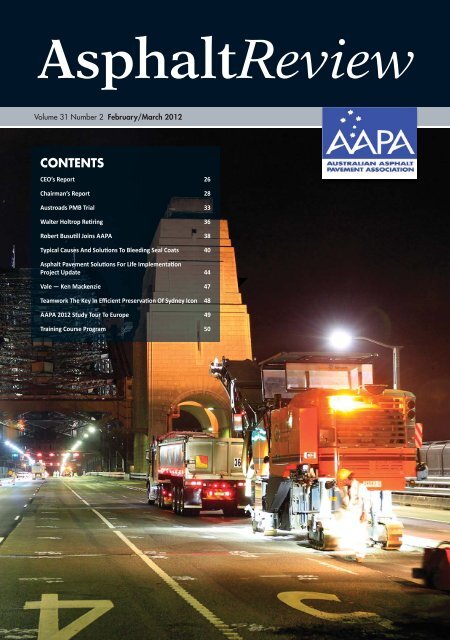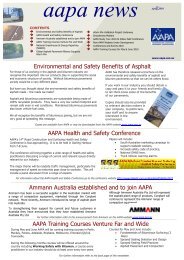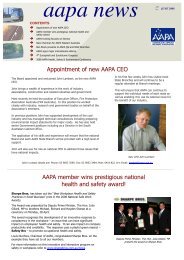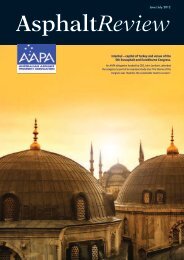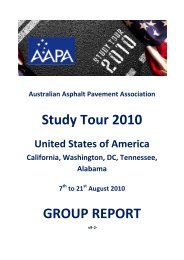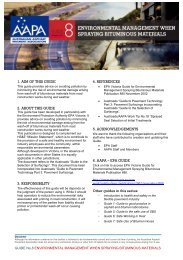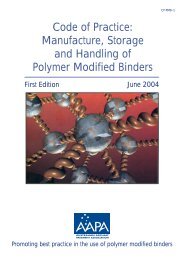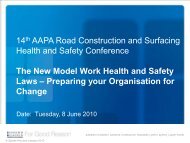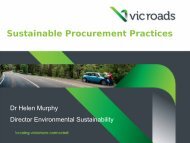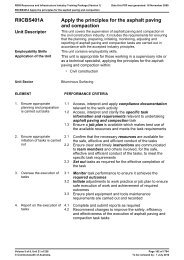Asphalt Review - Volume 31 Number 2 (Feb / Mar 2012) - Australian ...
Asphalt Review - Volume 31 Number 2 (Feb / Mar 2012) - Australian ...
Asphalt Review - Volume 31 Number 2 (Feb / Mar 2012) - Australian ...
- No tags were found...
You also want an ePaper? Increase the reach of your titles
YUMPU automatically turns print PDFs into web optimized ePapers that Google loves.
New Cat ® M Series.Ready when you arefor the AccuGrade advantage.
Anytime you’re readyThat’s when you can make the move to AccuGrade technology.Now – at no extra cost – every Cat M Series is built factory-ready for you toupgrade to AccuGrade technology.From January <strong>2012</strong>, every Cat ® M Series Motor Grader thatleaves the factory comes complete with everything you need tointegrate a Cat AccuGrade machine control system – quickly,easily and more economically.It’s another industry-leading innovation from Caterpillar –one that will save you both time and money.For example, when you’re ready to upgrade your machinewith a Cat AccuGrade grade control system, the factory-fittedcomponents will save you thousands, and the installation timeis more than halved.That’s a lot less downtime and you have the confidence ofknowing the inbuilt components are covered by your newmachine warranty because they’re part of the machine.What makes your next Cat M Series ‘ready when youare’ for AccuGrade?When you take delivery of your new M Series, it comescomplete with the following AccuGrade-ready components: automated operation performance and dependability system components wear protection and reliability, and an anti-vibration designfor long lifePower supply, main fallsensor and harnessesCab controls –display and joystickBlade sensors, bracketsand harnessesNote: These options can be installed atthe factory or available as dealer kits.For a limited time, AccuGrade-ready M Series is also finance-ready with6.5% * FINANCETo take advantage of this exclusive offer, contact Cat Financial on 1800 551 862.*All published rates are subject to change. Caterpillar Financial reserves the right to adjust rates at any time. All financing is subject to acceptance and credit approval by Caterpillar Financial30 ROADS FEBRUARY/MARCH <strong>2012</strong>
Why upgrade to AccuGrade?With Cat AccuGrade grade control systems, you can choose any combination ofcontrol to suit your specific requirements. AccuGrade has been field-proven onapplications that range from fine grading of roads, to building parking lots andcomplex 3D designs such as golf courses and roads with super elevations.AccuGrade Cross SlopePurpose-designed and integrated into the machine and hydraulic systems, AccuGradeCross Slope delivers precise and automatic blade control, enabling operators to gradewith complete accuracy. The system uses machine-mounted sensors and electronics toreport precise guidance information to the operator via an in-cab display. Expect greateraccuracy, higher productivity, lower operating costs, and more profitability, with operatorstaking fewer passes than ever before.AccuGrade SonicUses ultrasonic sensors that calculate elevation from a physical reference point – suchas a stringline, curb or gutter – to maintain elevation. The operator simply steers themachine to maintain the sensor over the reference point while automated featurescontrol the blade.AccuGrade LaserEmploys a rotating laser to create a grade elevation reference plane over the work area,maintaining precise elevation control while the operator steers the machine. The systemalso indicates cut/fill requirements to aid the operator.AccuGrade UTSUses a Universal Total Station (UTS) to track blade positioning and provide preciseelevation adjustments for fine grade control. It helps provide the information in agraphical display on the machine, showing relevant cut/fill information as well aslocation on the design. The operator drives the machine while the system controlsthe blade, helping to achieve fine grade surfaces with high-precision accuracy.AccuGrade GPSIncorporates a Global Positioning System (GPS) to provide precise location information andelevation control with centimetre level accuracy. Automated features control the bladeallowing the hydraulic system to position the blade while the operator steers the machine.
Easy maintenanceand longer lifeCritical components that really make the grade.When you introduce automated blade control technology, it’s important to keep tighttolerances for finish grade accuracy and quality of surface.That’s why we’ve designed our M Series with drawbar, circle and moldboard componentsthat are easy to adjust and replace, resulting in a longer, more productive work life.Patented, top-adjust, drawbar wear inserts can be easily adjusted by operators in the field –no need to call for a technician or head for the workshop.Plus they’re made of tough and durable nylon composite for longer life from day one –life and workability that can be extended even more with regular adjustment.What’s more, Cat M Series has six replaceable wear inserts that can be adjusted to prolonguse before replacement. It’s yet another example of the Caterpillar quality,smart thinking, innovation and value that continues to lead the way.For longer life and easier, more economical maintenance combined with more accurate,reliable fine grading, it pays to trust Cat M Series Motor Graders.It’s the surest way to make the grade.To find out more about the new M Series withAccuGrade-ready components, contact your localCat dealer or visit www.australia.cat.com/mseriesNSW/ACT - WesTrac: 1300 881 064WA - WesTrac: 1300 881 064VIC - William Adams: (03) 9566 0666TAS - William Adams: (03) 6326 6366QLD/NT - Hastings Deering: 1<strong>31</strong> 228SA - Cavpower: (08) 8343 1600© <strong>2012</strong> Caterpillar. CAT, CATERPILLAR, their respective logos, “Caterpillar Yellow,” the “Power Edge” trade dress as wellas corporate and product identity used herein, are trademarks of Caterpillar and may not be used without permission.
ASPHALT REVIEWDay 1 Inductions for Coober Pedy TrialsThermal imaging of Downer Sprayeracross Spray Bar & JetsAggregate Spreading & Rolling Operations Bitumen samles to be taken aer loadingthe srayer both before and aer theaddion of cuer and addie and The SAI S to be lant blended andsrayed from the SAI srayer. This wouldreduce the risk of otenal blockagesduring transfer to the owner srayer,as the bitumen traelled for more thantwo days a maimum of si hours fromblending to sraying is listed in the PTIsecicaon, and there were concernsof segregaon in the mi.The main obece of the trial was toassess the ability of the PB’s to resist crackreecon. In order to do this the followingtesng was undertaken ehiclemounted digital laser roler comleted before and aer srayingto obtain roughness, rung and tetureroeres. The teture roeresobtained rior to sraying were usedin the calculaon of sray ratestests conducted by eorge Sortalis PTI and sray rates designed by obBusul PTI rack maing comleted by SteePatrick AB rior to sraying to idenfycracks in the eisng seal and to beused to monitor roagaon of thesecracks through each roduct oer the lifeeectancy of the new seal Bitumen samles collected byliabeth Woodall AB beforeand aer the addion of addieand cuer at one art and two arts,resecely for arious laboratoryanalysis and tesng Infrared imaging hotos taken at thestart of each sray run by ym eaylonAB to cature the heat distribuonacross the eight metre bars and the lossin temerature from the bars to theeisng aement Sread rate calculaons comletedduring the aggregate sreading rocess bycatching the stone on a one–metre–by–one–metre lasc mat and weighing thecontents conducted by eorge Sortalisand Barry ullholland AAPA and Bitumen aer atches were le onthe road to be srayed oer andcollected for microscoic studies in thelaboratory samles collected by har eanhoo AB.As well as the tests described, hotograhswere taken before, during and aer srayingto document the condions throughoutthe trial. Barry ullholland and Walteroltro from AAPA, in conuncon withthe owner and PTI suerisors, untherBreindl and olin Fiebig, co–ordinatedthe sraying oeraons for the duraonof the trial. The works were to be comletedin two days, sraying four roducts er dayand allowing me in between sray runsfor the arious tests and samling of thebituminous roducts. ay inoled thealicaon of the four owner roducts,including crack–maing and samling allunder the watchful eyes of the Altus Tracanagement team.Slight adustments were made on the day,with a metre secon originally art ofthe trial being skied as the cracking wasnot suciently uniform in this secon. Theowner Australia srayseal team comletedall trial runs in an ecient, eece androfessional manner, resulng in a high ualitynish, ensuring that all tests conducted oerthe course of the monitoring rocess willroide comarable and accurate results forall obeces of the trial.In addion to the commendable work of theeld sta, this trial would not hae taken lacewithout the organisaon of owner sta Shawn umford Sray Seal anager, SteeAinscow Surfacing anager, and Adrianancini smator, as well as roect iniatorand co–ordinator, ob Busul PTI. It wasan interesng, ecing and, most imortantly,successful two days in which all aresassociated with the trial were roud to haebeen inoled.The second site near ooma in SWis a slightly smaller site but will enablea range of PB seals to be monitored ina dierent climac region to the South<strong>Australian</strong> trial. This is a slightly smaller sitebut will enable a range of PB seals to bemonitored in a dierent climac region tothe South <strong>Australian</strong> trial. The oomastage of the Austroads PB trial wascomleted in <strong>Feb</strong>ruary and like the ooberPedy stage was great success highlighngthe adantages of industry and goernmentworking together through Austroads and AAPAto achiee long term osie benets to theaement industry.The Cooma stage of the Austroads PMBTrial has been completed and, like theCoober Pedy site, was a great successhighlighting the advantages of industryand government working together.34 ROADS FEBRUARY/MARCH <strong>2012</strong>
ASPHALT REVIEWROBERT BUSUTILL JOINS AAPAWe are pleased to announce thatobert is a iil ngineer with many yearseerience in road surfacing, arcularly inthe area of Srayed Surfacing.Prior to oining AAPA, obert was theSuerising Surfacings ngineer with theSouth <strong>Australian</strong> eartment of Transortnergy Infrastructure PTI. In thisrole he roided technical adice relatedto bituminous surfacing, including thedeeloment of bituminous surfacingcontract secicaons and contributed to theimlementaon of the annual reseal rogram.One of his key achieements was theintroducon of erformance–based sealingcontracts into South Australia.obert has also reresented South Australiaon releant Austroads technical commieesand working grous. e has shown hisinterest and skills in training as a casuallecturer with the niersity of SouthAustralia resenng lectures to third yeariil ngineering students on the toicof Bituminous Surfacings.In his new role obert will be resonsiblefor connuing to deelo and resent AAPAtraining courses. e will follow in Walteroltro’s footstes to ensure that AAPAtraining courses are current and meet theneeds of our deeloing industry. e will addhis own skills and eerience to AAPA trainingand is already looking at new courses in areasof growing interest to AAPA members andtheir clients.In his new roleRobert will beresponsible forcontinuing todevelop andpresent AAPAtraining courses.An imortant role for obert will be tolook at new ways of resenng informaonincluding more use of mulmedia and the useof online facilies.e will use his secialised skills in srayedsealing to roide aluable and indeendentadice to our industry.obert is assionate about all things relatedto bitumen and beliees that the industry isof ital imortance to Australia. AAPA isindeed fortunate to hae been able to emloyobert to connue to grow on the great legacythat Walter is leaing in the form of AAPAtraining courses.The AAPA Board, members and sta allwelcome obert and look forward to workingwith him as he hels to train the current andnet generaon of eole across our industry.ike Walter, his secialised skills in srayedsealing will also roide a aluable resourceto our industry.Oer the net few months obert will tryto meet as many eole as ossible to helidenfy the riority needs of our industry.38 ROADS FEBRUARY/MARCH <strong>2012</strong>
If you need a cost-effective binder that will deliver improvedaggregate retention and extended life for high stress seals, talk tous about OLEXOBIT ® HSS. It’s a new solution to an old problem.Say yes to less stressOLEXOBIT ® HSS is a polymer modified binder that is designed for use in sprayed sealingapplications to achieve improved aggregate retention over conventional bitumen, where the sealis under medium to high traffic-induced stress.OLEXOBIT ® HSS is ideally suited for:Intersections, T-junctions and heavy traffic entrances involvingmoderate degrees of braking, acceleration or turning motionsSteep grades 5%Tight curves 50m radiusIt can also be used as a holding treatment on low traffic roadsOLEXOBIT ® HSS is an excellent alternative to C170 binders, delivering these four key benefits: PROVEN TECHNOLOGY YOU CAN TRUST – Features unique OLEXOBIT ® polymertechnology pioneered by BP PERFORMANCE – Improved aggregate retention COST – More cost-effective than the alternatives EASE OF USE – No specialty equipment requiredFor more information about OLEXOBIT ® HSS,visit our website: www.bpbitumen.com.aue-mail: bpbitumenaustralia@bp.comTechnical Helpline: 1800 24 88 66 (FREECALL)ROADS FEBRUARY/MARCH <strong>2012</strong> 39
ASPHALT REVIEWTYPICAL CAUSES AND SOLUTIONSTO BLEEDING SEAL COATSWalter Holtrop — National Surfacings Engineer, AAPAthe binder.INTRODUCTIONSustainability of the road network is achallenge for all road authories and societyis eecng imroed erformance of thenetwork and at lower costs and minimalimact on the enironment.It is esmated that u to 10 about 30000km of the naonal road network surfacedwith a srayed seal may not be sasfactoryfrom the oint of iew of not maintainingadeuate surface teture early in the sericelife of the seal.To achiee a sasfactory and eecesrayed seal reuires aenon to detail andmust take into account a risk assessment onthe robability of the seal being aroriatefor the condions, and if it fails can we liewith the outcome.The success of a srayed seals startsat the selecon of an aroriate treatmentsfor the trac and serice condions,followed by careful design of the ratesof alicaon of binder and aggregate,and construcon of the treatment at thearoriate me of the year, taking intoaccount reailing weather condions andminimising risk of failure.arly loss of serice life in srayed sealsdue to haing inadeuate surface teture is amaor concern with regards to otenal roadsafety issues. This cannot always be aoidedbut with careful aenon to the selecon,design and construcon the incidence ofbleeding seals can certainly be reduced,and there are roen remedial treatmentsaailable to restore adeuate surface tetureon bleeding seals.This aer resents an oeriewand highlights imortant stes on how tominimise otenal loss of teture early inthe life of a srayed seal, and raccalremedial treatments aailable to re–establishadeuate teture.FLUSHING VERSUSBLEEDING SEALSOn medium to heaily tracked roadssrayed seals gradually loose teture oer meand may only ust hae adeuate teture bythe me they reuire resealing. In thiscondion they are generally referred to asushed seals’, with minimum teture ofaround 1mm. At that stage the binder hashardened, ick–u on tyres is not an issue,and a normal reseal will roide the reuiredsurfacing characteriscs.On aerage, new seals do not seledown for a eriod of about two yearsaer construcon and this is taken intoconsideraon in the Austroads seal designmethod. If seals loose teture early in theirlife the binder is sll liely and near the to.of the aggregate this condion is classed asbleeding and there is the otenal for thebinder to be icked u on tyres and causedamage to the seal as shown below.These seals lack adeuate teture for safetyin wet weather, and binder ick–u will oenresult in a rough riding surface.At age two years this bleeding seal hadminimal teture. On a ery hot summer’sday the binder became ery tacky and ickedu resulng in damage to the seal. At thisstage, this damaged seal has been reairedwith cold mi, but needs maor reair riorto resurfacing.TYPICAL CAUSES LEADINGTO BLEEDINGnfortunately, at mes, srayed sealing isseen as a simle and low cost treatment forall occasions. To achiee a sasfactory andeece srayed seal reuires aenonto detail and must take into account a riskassessment on the robability of the sealbeing aroriate for the condions, and if itfails can we lie with the outcomeTyical causes idened that may result inbleeding include the following: Poor standard of aement rearaon The black stu is not what it used to be Selecon of an inaroriate treatment Poorly eecuted design Poor standard of seal construcon Timing of the treatment weather and neected increase in trac.On new works bleeding may be due to thegranular aement material not being ofa sasfactory uality for the condions.40 ROADS FEBRUARY/MARCH <strong>2012</strong>
Another factor is the aement rearaonbeing aimed rimarily at roiding a smoothsurface through heay watering and rollingof the surface, resulng in a ne and relaelyso slurry aste.ot allowing sucient me for dry backof the aement, together with the neslurry on to, increases the otenal forembedment of the aggregate to take laceonce oened to trac.On reseal work, the standard ofmaintenance does not aear to dierenatesuciently between normal rounemaintenance and being secically rearedfor a reseal. Of concern are the choice andtye of atching materials and alicaon,such as cold mi ersus hot mi and lackof comacon of these materials. A beerchoice, if raccal, would be to reair largerareas using granular material and alying anemulsion seal.Also of concern is the lack of sucient meallowed between maintenance atching andresealing. It is recognised budget constraintsmake it dicult but asset managers shouldroide dedicated funding for these workswell in adance.oss of teture due to embedment ofaggregate on new work where the aementwas not gien sucient me to cure. This maybe reented by: Adong sound construcon raccesand achieing aroriate comacon Allowing aement to dryback hecking otenal embedment withembedment hammer and Aoiding alying treatment in coldwetcondions.It is oular among many raconers toblame 10 as being too so and the causeof bleeding.A number of trials hae been carried outusing dierent conenonal binders, includingone made u in the eld of a 1:1 miture of10 and 30, with a iscosity of around0 Pa.s at 0 .These trials hae roen that the binderis usually not the main reason a seal bleedsin warm to hot weather and there is isuallylile dierence between the erformance oftrial secons constructed with 10, 0 and30 bitumen.There are a number of alternaes aailablesuch as using 0, 30 and mul–gradebitumen 0010. These lower the riskcomared to 10 but the ueson is by howmuch they hae otenally shorter life beforereuiring resealing and some suly issues atthis oint in me.A further alternae is to use Polymerodied Binders PB but these arerelaely eensie, more dicult to use atthe cooler mes of the sealing season, butminimise the risk of bleeding. ow to mediumPB grades are considered to reduce risk ata reasonable cost.One of the issues idened is the selecon ofan inaroriate treatment for the condions,and also choosing the cheaest seal oonwith a high risk of not erforming as eected.These hae become acceted standard inialtreatments rior to alying the nal surfacingselecon. Oen, as a result, not a lot ofthought is gien to the selecon and design ofrimerseals and the most common rimersealwould be one with 10mm aggregate using acutback bitumen rimerbinder. This may leadto unsuitable rimerseals being alied and tonot allowing sucient me to cure.ot much thought is gien to the netFIA treatment to comlete the works,such as what is it and when is it lanned tobe alied. There are many instances where asmaller aggregate would be more suitable, andgreater consideraon should be gien to whichis the more suitable rimerbinder, cutbackbitumen or bitumen emulsion.primerbinderThe rimerbinder should be allowed to cureand harden. A minimum of 12 months isrecommended with current tyes of cutbackbitumen rimerbinder. arder, faster curingrimerbinders are aailable and should beconsidered if there are concerns about the12 months me interal. sing say 320 asthe base binder for the cutback bitumen,and mm aggregate, would reduce the riskof the rimerseal adersely aecng theerformance of the nal seal.One of the issuesidentified is theselection of aninappropriatetreatment for theconditions, andalso choosingthe “cheapest”seal optionFinal sealing over bitumen emulsionprimerbinderThe caonic bitumen emulsion generallyused as rimerbinder contains only a erysmall amount of cuer and will cure fasterthan cutback bitumen. The recommendedminimum me is 3 months, and there is lessrisk when or mm aggregate is used.SPRAYED SEAL TREATMENTSThe following secon roides a uickoeriew of the two common tyes of sealtreatment. In Austroads we idenfy thesetwo tyes of seals by the number of layers ofbitumen and aggregate in the seal. ost common economical tyeof seal 10, PB, ulgrade 101mm aonal Austroads design method ore robust seal than asinglesingle for areas of high trac loadingand shear stress. Two layers of binder, and twolayers of aggregate 10, PB, ulgrade First layer is larger aggregatesecond layer is ideally half sie of rst layer,or smaller 2010, 20, 1, 10 mm aonal Austroads design method udated 2011Performance of D/D seal v S/S seal more robust and reduces risk ofstriingbleeding is a bit more eensie inially, butoset by longer life and reduced risk of noterforming as eected design using Austroads tended togie design rates at the higher end of theeneloe. This has been reiewed, with aiew to increasing teture on the comletedseal, and an amended design rocedure isto be ublished in late 2011 and Preferred construcon is both alicaonsalied with lile or no trac betweenalicaons.ROADS FEBRUARY/MARCH <strong>2012</strong> 41
ASPHALT REVIEWThe erformance of SS and sealscan be greatly imroed by using PB orulgrade instead of conenonal bitumenin areas of high stress. In Austroads we haeust comleted an amended Seal Seleconuide coering a large range of traccondions, climac condions, areas of hightrac loading and shear stress, and crackedaements, to assist in selecng the mostaroriate tye of seal for the condions.To deal with areas of etreme stressand high concentraon of commercial ehicleswe hae introduced an treme Stress SealSS tye using a highly modied PB inboth alicaons.This new selecon guide is eected to beublished together with the udate of theAustroads Seal esign method for seals.Inverted sealThis tye of seal is made u of two searateSS seals, a small aggregate as the inial sealfollowed by a larger aggregate seal some melater. ote: this is not an uside down seal. orrect eisng non–uniform teturerior to resealinginimie otenal aggregate embedmenton inial seals when sealing so basese.g. limestone resealing fay seals 10, PB, ulgrade Small generally or mm arge 1011mmAUSTROADS SEAL DESIGN(AP–T68/06)The current Austroads seal design is sllloosely based on the work done iniallyby F. anson. It was deeloed from anetensie naonal sealing trial and when usedcorrectly it roides aroriate design ratesof alicaon of aggregate and binder, takinginto account life of the seal and roidingadeuate surface teture, for a large range ofcondions and tyes of treatment.Two issues idened and udated in the200 ersion is the inuence of aggregateembedment and heay ehicles on theerformance of srayed seals with regard toroiding adeuate surface teture.To determine otenal embedment ofaggregate on new granular aementsreared for sealing we hae adoted usingthe odied Ball Penetrometer test, generallyreferred to as the ball embedment hammer.The Austroads design is based on theoriginal eublic of South Africa SA concetand we hae an arrangement to comareresults with SA with a iew to furtherdeeloment and use of this test on assessingotenal embedment when sealing oer othersurfacing such as, say, ashalt regulaon.AAPA recommends that all comaniesengaged in sray sealing oeraons urchaseand use this hammer to determine otenalembedment as art of the seal selecon anddesign rocess on new works.AAPArecommendsthat allcompaniesengaged inspray sealingoperationspurchase anduse this hammerto determinepotentialembedment aspart of the sealselection anddesign processon new works.DESIGN TRAFFICTrac olumes are based on AAT, and thenaoroned to each lane or secon of theaement to be treated to determine theesign Trac. Therefore, current accuratetrac olumes are essenal, including atleast the rooron of heay ehicles andlarge heay ehicles included in the AAT, todetermine correct rates of alicaon.The Austroads design was deeloed withinut from a naonal large scale sealingtrial. uring monitoring of this sealingtrial it became eident that with the raidincrease in large heay ehicles that someamendments were reuired to the seal designto comensate for these and minimise the riskof the seal not haing adeuate teture.A heay ehicle is classed as a commercialehicle of 3t or more, ranging from two alesu to si ales for a single semi–trailer. A largeheay ehicle is classed as a B–ouble or largetruck trailer combinaons haing a total ofseen ales or more. A tyical B–ouble hasnine ales.From raccal obseraons andstascal analysis of trac data relangto heay and large ehicles, it was concludedthat large heay ehicles hae about threemes the eect of normal heay ehicles.This resulted in the concet of uialenteay ehicles to determine anyadustment reuired in the design for theercentage of heay and large heay ehiclesin the design trac, where: as art of the esign Trac.Oen this is not considered adeuately inthe design, or done incorrectly. Including thecorrect adustment for these ehicles mayreduce the binder rate signicantly, by asmuch as 30% from the standard design.PMB FACTORSWhen a seal treatment is selected as a ighStress Seal SS or treme Stress SealSS, or as a Strain Alleiang embraneSA, a PB Factor is used in the design todetermine the aroriate binder rate for thesecic treatment.Oen designers will use the same PBfactor for all treatments and grades of PBand this is not aroriate. The PB Factorsrange from a Factor of 1.0 SS to as high as1.3–1. SA. If, for eamle, the SA Factoris used for a SS design this could result in adesign with an ecess of u to 30% of binderfor the condions.It is therefore ery imortant that thedesigner determines why the PB is usedand which tye and grade of PB in orderto determine the correct PB Factor forthe design.An unsasfactory Final SS Seal constructedusing a PB as art of the treatment. and not considered adeuately, lus incorrectPB Factor, leading to early bleeding andick–u of the binder. The maor roblem nowis how to correct this to achiee a sasfactorylong life srayed seal surfacing.The design of binder rates of alicaonis determined for the wheel aths. In manycases the teture outside the wheel athis much coarser and reuires more binder.It is considered a normal SS seal can roidea sasfactory seal if the dierence in binderrate in the wheel ath and outside the wheelath does not eceed 0.2 m.By taking into account the ariable surfaceteture we can reduce the risk of early42 ROADS FEBRUARY/MARCH <strong>2012</strong>
striing in coarse areas/bleeding in thewheel aths. If the dierence is, for eamle,0.3/m or greater, to achiee a sasfactoryuniform tetured seal, the following oonsshould be considered: Aly a correcon seal or micro–surfacingrior to resealing Sray dierent rates of alicaon acrossthe aement. This can be done using asingle srayer doing 2 runs, 2 srayersfollowing each other or using a srayerdesigned secically to be able to alyariable transerse rates of alicaon.CONSTRUCTION PRACTICESSrayed seals are best done in warm anddry condions. This is of course not alwaysossible and some work has to be donein the cooler mes of the sealing season.This increases the risk of failures such asstriing of the aggregate, arcularly whenusing PB binders, or bleeding in the neteriod of hot weather.Although deeloed for all–year use,rimersealing in wet/cool/cold condionsincreases the risk of loss of aggregate or thetreatment not bonding to a wet and coldaement. This can be minimised to someetent by using an aroriate bitumenemulsion and some careful trac control.It is referable if the construcon rogramcan be amended to aoid the coldest/weestcondions. sing dry and re–coated aggregatecan further reduce the risk.igher risk of failure due to: ooler weather work done late in theseason and then subect to sudden increasein temeratures in early summer can resultin bleeding. ooler weather increased risk of striingof aggregate. This is then oen reairedusing a small aggregate in down seal toreent further aggregate loss. enerallythe two alicaons of binder result inoer–alicaon and increases the risk ofbleeding in hot weather. igher trac olumes, and in arcular ahigh ercentage of commercial ehicles,increases the risk of failure. Short termtrac increases due to secial eents, crocartage etc also increase the risk and it isreferable to defer the work if ossible. uer content reuired cool weatherreuires addional cuer to wet theaggregate and establish the bond. uertakes about 12 months for most of it toeaorate and leaes a so binder in thewarmerhoer condions. aintenance atching atchingcracklling ust rior to resealing At the start and end of the sraying seasonnot allowing for the cooler condions atnight, usually resulng in striing reuiringremedial treatment. ot changing work racces in general toreect the cooler weather condions.TREATMENT OF BLEEDING SEALSThe main reasons bleeding seals reuiretreatment are: Proide adeuate skid resistance educe maintenance costs Aoid ehicle damage Aoid damage to the srayed seal.In general, the earlier a roblem sealis treated, the more eece the remedialtreatment and the lower the cost. Theworst condion is usually aer seeralconnuous hot days and nights resulngin a relaely so binder allowing theaggregate to more closely ack togetherforcing the binder towards the surfaceand/or embedment of aggregate intoa so underlying surfacing. ecetreatments include: Aly water to cool down the seal Aly grit, sie /mm recoated aggregateto aoid ick–u of the binder anddamaging the seal If readily aailable, aly clean hot’aggregate from an ashalt lant.Longer term treatmentThis includes: Alying solent and small aggregate igh Pressure Water blasng or shot blasng.This treatment can be alied by a smallsraying crew using commonly aailablematerials and euiment used in eerydaysrayed sealing oeraons.The solent is alied and allowed tosoen/wet the eisng binder and thencoered with recoated sie or mmaggregate, and rolled. Aggregate will only sckwhere there is sucient binder to retain it,but it kees the tyres out of the bitumen andreents ick–u.Solents used successfully include kerosenecuer, highly aromac kerosene androrietary materials e.g. such as gilsabind.The treatment is most eece whenalied in warm to hot weather condions.Secial high ressure water blasngeuiment has roen to be able tosuccessfully remoe ecess binder from ableeding or ushed seal to restore teture.Similarly shot blasng may be used but thebinder to be remoed must be relaely hardfor this to work eecely.The aim is to restore surface teture toabout 1 to 1.mm deending on theaggregate sie. et the treatment sele downand resist resealing it too soon.An eamle of teture restored in wheelaths of a road carrying medium tracolume, with about 10% heay ehicles andery few large heay ehicles.Age of water blasng: oer 2 years sincesurfacing was water blasted and sll hasadeuate teture and is not eected toreuire any further treatment for at leastanother coule of years.CONCLUSIONSrayed seals can roide high ualityand long life surfaces at low cost.oweer, to achiee a sasfactoryresult reuires aenon to detailand it must be aroriate for thecondions. Blaming seal failures suchas bleeding is common, but it is notusually the reason a seal fails.Instead, the success of a srayedseals starts at the selecon of anaroriate treatments for the tracand serice condions.This is followed by careful designof the rates of alicaon of binderand aggregate, and construcon of thetreatment at the aroriate me ofthe year, taking into account reailingweather condions and minimisingrisk of failure.This paper is an overview of the reasonsfor seal failures and the appropriateROADS FEBRUARY/MARCH <strong>2012</strong> 43
ASPHALT REVIEWASPHALT PAVEMENT SOLUTIONSFOR LIFE IMPLEMENTATIONPROJECT UPDATEIan Rickards, AAPA Consultant.achieve long term pavementThis message was reinforcedother countries around the world.provided to highlight some of theOBJECTIVES OF THE ASPHALTPAVEMENT SOLUTIONS (APS–FL) —FOR LIFE PROJECTThe obece of the APS–F roect is toimroe the eece deloyment of ong ifeAshalt Paement AP structures within<strong>Australian</strong> highway construcon racce.These are referred to as eretual aementsas they are designed such that the fagueendurance limit of the aement materialwill not be eceeded. This means that theaement will last indenitely with ust theto wearing course being maintained. Thisensures that the aements use the omumamount of material and reuire minimalmaintenance oer ery long eriods. In the S,some eretual aements are oer 0 yearsold and sll erforming well.APS–FL PROJECT ACTIVITIESThe APS–F roect comrises a numberof research acies which are describedin detail in the aer. The e maoracies are: iterature reiew aonal ashalt materials characterisaonstudy AP thickness design sowaredeeloment alidaon of AP thickness design by TPPstudies nironment and sustainability.Together these will lead to an amendedaement design rogram within Iand informaon to suort industry andgoernment to use this design aroach.LITERATURE REVIEW — SUMMARYOF PERTINENT FINDINGSOutcomes in the literature reiew focussed on:This was done to enable the idencaonand selecon of AP’s to be subected toanalyses in the APS–F roect to calibratedesign models.The literature consistently reorted crackinginiang at the surface and migrangdownward.The ighways Agency thickness designchart shows the design thickness of ashaltincreases with design trac u to 0 SAillion Standard Ales and then asymtotes.This is based on the emirical eidencethat ashalt aements which surie 0SA ehibit AP erformance and deeconhistory. oweer, in Australia, traccondions and temeratures ary from the. ence the eerience would need tobe alidated and calibrated for Australia.endurance limitThe concet of the ashalt fague endurancelimit was ostulated in the early 0s fromobseraons of laboratory eure tesng.onsiderable research has connued sincethat me and, while there is widesreadaccetance of the laboratory fagueendurance limit concet, its imlementaoninto the AP design is not yet commonlace.The fague endurance limit concet wasthe subect of a maor S study under Proect 0–. One of the key issues underresearch is the healing of micro–cracks andrestricon of fague crack roagaon fromthe boom of the ashalt base.The literature cites a number of researchersoer many years who hae obsered thehealing henomenon that occurs when resteriods are introduced into the loading cyclesin the laboratory. Obseraons indicate thatthe rate of healing increases with temeratureand the duraon of rest eriods thus it isreasonable to conclude that the healingof micro–cracks in the warmer <strong>Australian</strong>aement enironment will be greater relaeto colder climes e.g. much of the SA, and uroe.urrent ashalt thickness design in Australiaignores healing.esearch conducted at the AT test trackin the S includes among other constant44 ROADS FEBRUARY/MARCH <strong>2012</strong>
Cumulaedistribuon %10080100908070Cumulaedistribuon %60604020CanberraMelbourneSydneyDarwin50403020CanberraMelbourneSydneyDarwinCAT tentae limit100010 20 30 40 506000100 200 300 400Paement Temerature °CTensile strain boom of ashaltmonitoring of the aement temerature andstrain ersus load alicaons, and regulardeecon tesng. The comarison of the elderformance and the cumulae distribuonof strain for each test secon suggest theeistence of a liming cumulae distribuonof strain to aoid ashalt fague cracking. AThas ublished a tentae liming cumulaedistribuon of ashalt strain to aoid cracking,but obseres that the trac leel was in theorder of 20 SA, much less than commondesign alues for trac loading on AP’s.The cumulae distribuon of ashalt strainwill ary with the alied ale grouse.g. single, tandem and triale and load mass.In <strong>Australian</strong> racce, the diersity of loadingis reduced to reeons of the standard 0kale based on the remise that eual damageis inicted by dierse ale grou roided theyroduce eual maimum deecon. Thisraised the ueson as to whether ariaonsin ale mass conguraon and oerloadingshould be taken into account when designingAP. Aer reiewing the literature it wasconcluded that there is no signicant benetin doing a detailed AP erformance analysisusing the comle distribuon of ale masseen if it were aailable.onsiderable research was undertaken byr ickenson AB in the 0s on aementtemerature in Australia and this highlightedthe comleity of the elements contribungto the aement temerature and gradient.Addional studies hae also been done inother countries.It is ostulated that the conserasm in theesmaon of the standard ale reeonsused in the esmaon of the cumulaestrain distribuon will more than oset anyinaccuracies in the esmaon of the releantaement temerature sectrum.The study will focuson the standardasphalt materialsproduced byAustralia’s majorasphalt producersfor use in majorprojects wherethe LLAP conceptis most likely tobe implemented.NATIONAL ASPHALT MATERIALSCHARACTERISATION STUDYThe urose of the ashalt materialscharacterisaon comonent of the AshaltPaement Soluons For ife APS–Froect is to roide hard data on theerformance characteriscs of <strong>Australian</strong>ashalt materials.Consistent with the direcons being takeninternaonally, dynamic modulus mastercures will be generated in order to enablethe deriaon of mi modulus and isco–elasc roeres across the sectrum oftemerature and load freuency ernent to<strong>Australian</strong> eld condions. Addionally, thecomle shear modulus master cure willbe generated for the bitumen and bitumenmasc comonent of the mies.There are two main obeces for thematerials characterisaon comonent of theAPS–F roect: The material roeres will be used inCIC layered elasc design analyses todetermine the cumulae distribuonof ashalt strain oer the aementtemerature and loading sectrum. The material roeres will be comaredwith materials manufactured in the S anduroe to conrm similar erformance, thusthe transferability of their research. This willfacilitate the adoon and imlementaonof the ndings of their ong Term PaementPerformance TPP roects20.The erformance characteriscs of ashaltare rimarily inuenced by the followingkey factors: i sie and gradaon Bitumen tye and content Aggregate tye and roorons Air oid content.The study will focus on the standard ashaltmaterials roduced by Australia’s maorashalt roducers for use in maor roectswhere the AP concet is most likely to beimlemented. Aroimately 30 mies haebeen idened for the study and will coerthe sectrum of aggregate tyes and non–modied <strong>Australian</strong> bitumen.Ashalt samles will be taken from lantroducon, cooled and deliered to thelaboratory. Aer reheang, the mi samleswill be comacted in the shear bo comactor.When the reuired samle mass is determinedfour ashalt samle risms will be manufactured one to be cored for APT tesng i.e. 3by 100 10mm cylinders one for ossiblefague tesng and two held in resere forcorrelaon studies with oerseas agencies andfor uneected issues.The S generally uses the Sueraeyratory omactor S for samlecomacon and it is to be eected that theAPT results on samles manufactured usingthis mode of comacon may ary relae toROADS FEBRUARY/MARCH <strong>2012</strong> 45
ASPHALT REVIEWshear bo comacted samles. A small subsetof mies will therefore be tested aercomacon in the Seroac gyratorycomactor, which is belieed to relicate theSC and the scale of any ariaon recorded.nder normal circumstances the AMPTdynamic modulus test inicts lile damage onthe samles ecet at high temerature, slowloading freuencies which are conducted last.Accordingly, these samles may be sent oerseasfor correlaon studies to limit the number ofariables. Alternaely or, as well, addionalcores can be cut from the surlus risms.The ashalt samle risms will be cored toroduce three cylinders and the density ofthe trimmed samles will be calculated andtested for consistency and conformity with thetarget oids. Only two of the three cylindricalsamles are to be tested in the AMPT.The activity willdevelop PerpetualPavement designsoftware based onthe layered elasticprogram CIRCLYLLAP THICKNESS DESIGNSOFTWARE DEVELOPMENTThe acity will deelo Peretual Paementdesign soware based on the layered elascrogram CIC which is currently adoted inAustroads Paement Design uide APD.The roosed modicaons to the currentAPD method, secically for AP design are The use of ashalt materials characteriscsderied by laboratory measurement thatcoer the sectrum of temerature andload freuency anciated for secicAP roect locaons. The use of trac loading data to reresentthe distribuon of loads oer the aementtemerature sectrum. Calculate the cumulae distribuon ofthe ashalt strain under the design 80k standard ale loading oer the sitetemerature sectrum. Comare with the interim limingcumulae ashalt strain distribuon to bealidated against TPP studies of AP’s toensure comliance.VALIDATION of LLAP THICKNESSDESIGN BY LTPP STUDIESThe following rocedures suggested for use inthe alidaon of the roosed AP thicknessdesign rocedure are in the lanning hase.ssenally the alidaon rocess inoles thedesk to analysis of oerseas TPP data.The work will be carried out in the courseof PhD studies in nominated niersies.The interim methodologies roosed relyon access to data that has been obtainedby oerseas researchers and agenciesand by <strong>Australian</strong> researchers roidingsulementary resources to those agencies.The alidaon rocess is considered toentail two rimary facets ericaon of alues for use in APdesigns e.g. using CAT data ericaon of AP design method byTPP studies.These are briey outlined in the following.The alues will ary between laboratoryand eld condions. The sources of ariaonare numerous and include the dierentmiing and comacon condions, theetent of ageing and arcularly at hightemeratures the degree of connement.It is thought that the crical condion isearly in the life of the aement when themi is fresh i.e. strain is at a maimum, thuslaboratory characterisaon of lant miedsamles robably reresents the worst casescenario roided the samle density/oids iseual to the eld condion.As reiously noted, the tyical <strong>Australian</strong>ashalt lant mied materials reresenng thoseused on maor roects will be characterisedusing the AMPT. The relaonshis soderied will then be comared with those ofthe materials in TPP studies oerseas. If itcan be established that the ashalt materialshae similar roeres it is then reasonable toassume the TPP results would be alicableto the <strong>Australian</strong> scene under similarcondions of load and enironment.The interim AP thickness design roosalrelies on comliance with a liming cumulaedistribuon of strain under the euialentstandard ale oer the sectrum of aementtemerature. CAT in the S has suggestedan interim tolerable cumulae distribuonof strain but further ericaon andcalibraon is reuired.umerous sites and uroean hae beenidened that clearly achiee the AP statusi.e. the aement deecon is reducing withme. With the assistance of the ighwaysAgency and/or T and the members of theuroean ong ife Paement Assessmentrou PA details of some of theseaements may be aailable. With knowledgeof the aroriate climac data, the cumulaestrain distribuon in these aements may bedetermined for comarison with and ossiblerenement of the CAT model.The calculated strain will be deried usingthe sectrum of alues esmated fromback–analyses and ossibly calibrated againstlaboratory measures or redice modelsusing consistent assumons of ambienttemerature ersus aement temeratureand load duraon.The back analysis of deecon data takensoon aer construcon will enable theesmaon of the cumulae distribuon ofstrain in the AP at what is generally regardedas the crical condion i.e. in fresh ashaltmaterial when rst tracked.ENVIRONMENT ANDSUSTAINABILITYFinal details of the enironmental studieshae not been comleted. oweer, they willfocus on idenfying the sustainable benetsachieed through the design of aementsthat use the aroriate amount of materials.This recognises that under the current designaroach some aements in Australiaare being oer designed, wasng bitumen,aggregate and energy in their manufacture.This also adds addional costs to a aement.The enironmental studies will also includean assessment of the saings arising from along life aement that reuires ust occasionalrelacement of the to wearing course.This not only saes resources and economiccosts, it also reduces the costs associatedwith trac congeson during maintenance.This recognises that a wearing course can beuickly relaced oer one or two nights, unlikealternae surfaces such as concrete thatreuire signicant me to reair.CONCLUSIONperpetual pavements achieving both46 ROADS FEBRUARY/MARCH <strong>2012</strong>
ASPHALT REVIEWVALE — KEN MACKENZIEINAUGURAL EXECUTIVE OFFICER& AAPA LIFE MEMBERThose inoled in AAPA’s early days, and inthe deeloment of the industry in the 60s,70s and 80s regret and are saddened by theassing of en Mackenie, eacefully onSunday oember 27, at the age of 87. Agewas the nal conueror of en’s infecous estand boundless energy and enthusiasm.en was ery well known and highlyregarded as Shell Australia’s Bitumen Managerthrough the sies and early seenes. It wasin the late 1960s while sll emloyed withthe Shell Comany of Australia that hebecame the <strong>Australian</strong> Ashalt PaementAssociaon’s AAPA inaugural ecueOcer. In 1972 he was seconded from Shellto take u the full–me osion as the rstAAPA ecue Director.is dedicaon and caabilies rmlyestablished AAPA as a resected tradeassociaon both in Australia and oerseas.Following en’s rerement in 1980, hissuccessor in the AAPA CO role was, ayFarrelly, also to become an AAPA ife Member,who has said it was en’s establishmentof a solid and resected foundaon thatroed inaluable for the success andendurance of AAPA oer the 40 years sinceen took the helm.“Very few associations, especially in theasphalt and bitumen sector worldwide,have had such a long and highly regardedprofile, and Ken played a highly significantrole in the formative years of AAPA.ery few associaons, esecially in theashalt and bitumen sector worldwide, haehad such a long and highly regarded role,and en layed a highly signicant role in theformae years of AAPA.e was recognised for this by the awardingof ife Membershi in 1983, and by the manyfriends and resected colleagues he generatedalong the way.Following his life aer AAPA, enconnued roiding eerse to the industryas a riate consultant, but broadened hisinterests and acies.Aer a few years he took on the ecueOcer role for the andscae ardenersAssociaon, a short term undertakingthat he connued in for well oer 10 years.In addion to triing around gardens, hebecame assionate about ballroom dancingand maintained his health and itality almostto the end with regular, and reorts indicate,uality oerings on the dance oor.Only in the last year or so did en slowdown as his body couldn’t kee u with hismind and assion.is etensie and broad range of friendsoined his family to bid farewell to their friendand beloed one in a style en wanted lileceremony but with close ones gathered. ewas remembered as a comassionate and truefriend, always with energy and for being a bitof a scallywag, with family and friends at lasthaing the last say.AAPA remains indebted to en Mackeniefor roiding the solid foundaons on whichthe Associaon has ourished.ROADS FEBRUARY/MARCH <strong>2012</strong> 47
ASPHALT REVIEWTEAMWORK THE KEYIN EFFICIENT PRESERVATIONOF SYDNEY ICONssenal maintenance work was carried out on the iconic Sydneyarbour Bridge oer the two weekends of anuary 13–16 andanuary 20–23.For the rst me in the history of the grand bridge, due to celebrateits 80th birthday on 19 <strong>Mar</strong>ch <strong>2012</strong>, it was stried back to the originalconcrete deck to enable new waterroong to be alied and followedby ashalt resurfacing.Proision had been made for the works to otenally occuy threeweekends of bridge closure to general trac but, desite heay raininterrung rogress at mes, the works were comleted to enablethe bridge to be re–oened 10 hours ahead of schedule on the secondSunday, anuary 22.Seaking aer the imressie undertaking of the roect, theSW Minister for oads Ports, Duncan ay, and the Chief ecueof oads <strong>Mar</strong>ime Serices, Peter Duncan, thanked all those inoled.Mr ay and Mr Duncan raised the dedicaon to teamwork, thedetailed lanning, the skills and commitment of all aresin oercoming the dicules osed by the weather and the roectitself in securing its successful eecuon with minimal disruonto the ublic.They also acknowledged the intensely scheduled works wereundertaken with no safety incident or inury recorded. Theirlaudits embraced oads <strong>Mar</strong>ime Serices eecue androect management, the Trac Management Centre, the rolingcrews, the waterroong contractors and the ashalt suly andlacement teams.AAPA would also like to acknowledge the eorts of its memberswho arciated as team members in the achieement of thesuccessful outcome and demonstrated so well the skills and caacityheld within the <strong>Australian</strong> eible aement industry.AAPA members inoled include oads <strong>Mar</strong>ime Serices,Boral Ashalt, Downer Australia, SS oads, Base Course Management,oadwor and Sydney oad Proling.We lan to bring you a more detailed arcle on the arciaonof members, together with technical details of the roect and itseecuon in the net edion of <strong>Asphalt</strong> <strong>Review</strong>.48 ROADS FEBRUARY/MARCH <strong>2012</strong>
ASPHALT REVIEWAAPA <strong>2012</strong> STUDY TOURTO EUROPEAAPA has, for many years, oered it membersand guests the oortunity to meet with someof the world’s eerts in our industry throughfocussed study tours.In une of this year, AAPA will be holdinganother study tour ising key uroeanresearch bodies, industry and goernmentagencies, and nishing in Istanbul, Turkey, atthe 5th uroashalt urobitume Congress.As with reious study tours, the <strong>2012</strong>uroean Tour will hae a full rogram ofisits and meengs with key ersonnel andresearchers in uroe.The nal details of the tour will bedetermined oer the net few months inconuncon with delegates and workingclosely with uroean colleagues. oweer,the roisional key toics are:1. ong life aements: eerience, designsystems, use, durability and erformance2. igh erformance ashalt binders: highmodulus ashalt M, iMA, modiers3. Sustainability: carbon calculators energy analysis, climate change imacts,societal concerns4. ealth Safety: construcon of roadworks, health consideraons for bitumenand ashalt roducts, resonse to theIAC decision on fumes and5. Procurement systems: rorietaryroducts Ais Techniue, APAS, etc,green rocurement, AC, resonsiblesourcing, PPP and contract models.For those who hae undertaken an AAPAstudy tour, you will know it makes use of closelinks with bodies such as the uroean AshaltPaement Associaon, the InternaonalBitumen mulsions Federaon IBF andurobitume, as well as contacts throughAAPA’s members with maor oces in uroe.The tour is currently scheduled to deartFriday 1 une and return ost 5th COSS on 17 une. It will be led by ohnambert AAPA CO and ob oss AAPA ldecue Ocer. Desnaons are the nitedingdom, France, etherlands /or Sainand Turkey. Also deending on demand, a ostconference tour may be organised to Germany Switerland.At this stage, the agencies and organisaonsroosed for a isit are:ighways Agency, T,ened Bitumen Associaon and anoil comany undertaking research anddeeloment on key toics.France: CPC, Colas, IBF, and Tosas.Del Technical niersity, oadsAgency, and industry contractors.esearch organisaon, andindustry contractors.Congress and lant euimentsuliers.Plant euiment suliers androduct suliers. Plant euiment suliers.Euroasphalt & Eurobitume CongressThe urosahalt and urobitume Congress Congress is held once eery four yearsand is the maor eent of its tye in uroe.It is recognised as the remier eent focussingon ashalt and bitumen across the world. Assuch, it aracts a ery wide range of currentand toical aers.This year its theme of Ashalt, TheSustainable oad To Success has lead to arecord number of 391 abstracts being receiedfrom around the world.Informaon on the congress notes thatsustainability has become an oerarchingtheme touching all asects of what ourindustry does. While much of the obiousfocus of sustainability is on enironmentalasects, it is a much broader concet.Sustainability has three interlinking themes:enironmental, social and economic. Thesecan be summarised in the following foursustainability obeces. ece rotecon of the enironment Prudent use of natural resources Social rogress which recognises the needsof eeryone and Maintenance of high and stable leels ofeconomic growth and emloyment.The Program Commiee is holding eightstreams addressing the following themes:1. nergy and Carbon2. Durability erformance mitures andbinders and aements3. esource use and recycling4. Adang to climate change5. Societal imact6. esonsible sourcing and greenrocurement7. Imroing ealth Safety isibility and8. Financing of road infrastructure andmaintenanceFor further informaon about the 5thuroashalt urobitume Congress refer to theConference website www.eecongress<strong>2012</strong>.org.Previous AAPA Study ToursAAPA study tours are run at a ery fast ace toensure that delegates gain the maimum fromthe eerience. To highlight this, it is worthreiewing the reorts from the two mostrecent study tours.During 2010, AAPA organised a maor studytour to the S roiding reresentaesfrom Australia’s industry, goernment andacademic sectors with the oortunityto meet with eerts from across the S.This included key ersonnel from the Saonal Ashalt Paement Associaon, stateashalt associaons, the Federal ighwayDeartment, and industry and maor researchbodies such as CAT.This tour focussed on e key toics:Peretual Paement Concets, Warm MiAshalt, ecycled Ashalt Paements AP,Accelerated Paement Tesng and uiment,General Issues binders, srayed sealing,surface fricon.Following this tour there hae beensignicant adances in Australia’sunderstanding of these key issues. For eamle,there has been a signicant increase in theunderstanding and use of warm mi ashaltand reclaimed ashalt aement in manystates. The knowledge of eretual aementsalso has greatly suorted the AAPA AshaltPaement Soluons For ife roect.The 118 age study tour reort is aailablefor download from AAPA website www.aaa.asn.au under the heading Technical Study Tour 2010).As a direct result of this tour, AAPA alsoheld a mini tour to South Africa in 2011.SouthAfrica has many similar aement issuesto Australia.The reort on this tour is also aailable fromthe AAPA website.or email: rob.vos@aapa.asn.auROADS FEBRUARY/MARCH <strong>2012</strong> 49
ASPHALT REVIEWTRAINING COURSE PROGRAMFEBRUARY <strong>2012</strong>Date Course ocaon State Code14 Fundamentals of Bituminous Perth WA TC1201Surfacing14 Fundamentals of Bituminous Melbourne IC TC1202Surfacing15 Selecon of PaementPerth WA TC1203Surfacing15 Selecon of PaementMelbourne IC TC1204Surfacing21 Fundamentals of Bituminous Brisbane D TC1205Surfacing22 Selecon of PaementBrisbane D TC1206Surfacing28 Fundamentals of Bituminous Sydney SW TC1207Surfacing29 Selecon of Paement Surfacing Sydney SW TC1208MARCH <strong>2012</strong>Date Course ocaon State Code6–7 Srayed Sealing Selecon Dubbo SW TC1209 Design7 Srayed Sealing Design Dubbo SW TC12108 Srayed Sealing Field Procedures Dubbo SW TC121120–21Srayed Sealing Selecon DesignBrisbane D TC121221 Srayed Sealing Design Brisbane D TC121322 Srayed Sealing Field Procedures Brisbane D TC121427–28Srayed Sealing Selecon DesignMelbourne IC TC121528 Srayed Sealing Design Melbourne IC TC121629 Srayed Sealing Field Procedures Melbourne IC TC1217APRIL <strong>2012</strong>17 Fundamentals of Bituminous Adelaide SA TC1218Surfacing18 Selecon of Paement Surfacing Adelaide SA TC1219MAY <strong>2012</strong>Date Course ocaon State Code1–2 Srayed Sealing Selecon Sydney SW TC1220 Design2 Srayed Sealing Design Sydney SW TC12213 Srayed Sealing Field Procedures Sydney SW TC122215–16Srayed Sealing Selecon DesignPerth WA TC122<strong>31</strong>6 Srayed Sealing Design Perth WA TC122417 Srayed Sealing Field Procedures Perth WA TC122529–30Srayed Sealing Selecon DesignAlbury SW TC122630 Srayed Sealing Design Albury SW TC1227<strong>31</strong> Srayed Sealing Field Procedures Albury SW TC1228JUNE <strong>2012</strong>Date Course ocaon State Code5 Polymer Modied Binders Brisbane D TC1229Bituminous mulsions6 Paement Maintenance Pracces Brisbane D TC12307 Ashalt Placement Comacon Brisbane D TC12<strong>31</strong>26 Polymer Modied Binders Melbourne IC TC1232Bituminous mulsions27 Paement Maintenance Pracces Melbourne IC TC123328 Ashalt Placement Comacon Melbourne IC TC1234JULY <strong>2012</strong>Date Course ocaon State Code3 Polymer Modied Binders Sydney SW TC1235Bituminous mulsions4 Paement Maintenance Pracces Sydney SW TC12365 Ashalt Placement Comacon Sydney SW TC12376 Working Safely With Bitumen Perth WA TC123810 Working Safely With Bitumen Adelaide SA TC123912 Working Safely With Bitumen Melbourne IC TC124020 Working Safely With Bitumen aunceston TAS TC124124 Working Safely With Bitumen obart TAS TC124224 Srayed Sealing Selecon Design Adelaide SA TC124325 Srayed Sealing Design Adelaide SA TC124426 Srayed Sealing Field Procedures Adelaide SA TC124527 Working Safely With Bitumen Mogo SW TC1246<strong>31</strong> Working Safely With Bitumen Sydney SW TC1247AUGUST <strong>2012</strong>Date Course ocaon State Code3 Working Safely With Bitumen Tamworth SW TC12487 Working Safely With Bitumen Brisbane D TC12497–9 Bituminous Surfacing Melbourne IC TC1250Princiles and Pracce10 Working Safely With Bitumen Gold Coast D TC125121–23Bituminous Surfacing Princiles and Pracce28 Polymer Modied Binders Bituminous mulsionsBrisbane D TC1252Adelaide SA TC125329 Paement Maintenance Pracces Adelaide SA TC125430 Ashalt Placement Comacon Adelaide SA TC1255SEPTEMBER <strong>2012</strong>Date Course ocaon State Code4–6 Bituminous Surfacing Sydney SW TC1256Princiles and Pracce11 Polymer Modied Binders Perth WA TC1257Bituminous mulsions12 Paement Maintenance Pracces Perth WA TC125813 Ashalt Placement Comacon Perth WA TC125950 ROADS FEBRUARY/MARCH <strong>2012</strong>


